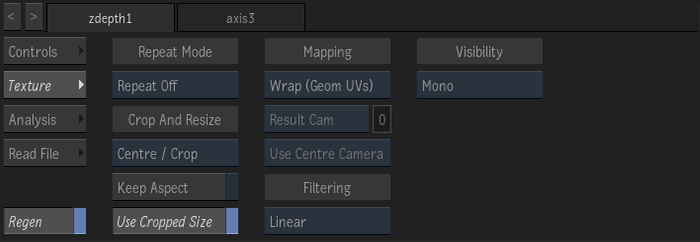The Parallax menu is divided into two tabbed sections: Controls and Texture.
Controls Tab

- Regen button
- Enable to dynamically refresh the image as changes are made to the parallax settings.
- Scale field
- Displays the perceptual height of the texture driven by the parallax map. Editable.
- Bias field
- Displays the distance between the real surface of the object and the perceptual ground (zero level) of the texture. A value of half of the Scale field value should give the best results.
- Attenuate field
- Displays the level of amplitude of the effect caused by the parallax map texture. Editable.
- Softness X field
- Displays the amount of X-axis blur applied to the parallax map. Editable.
- Softness Y field
- Displays the amount of Y-axis blur applied to the parallax map. Editable.
- Relief Mapping button
- Enable to augment the 3D surface detail by creating occlusions where changes occur in the parallax map. Rendering is slower when enabled, but the results may be better.
- Linear Search field
- Displays the number of steps to search for the best depth in the relief map. Editable.
- Binary Search field
- Displays the number of steps to refine the precision of the best depth found by the linear search. Editable.
- Bump Normals button
- Enable to allow the parallax map to create a normal map for enhanced lighting effects. Used only if no normal map exists for object using the parallax texture. Enabling also affects the Normal output in Action.
- Depth field
- Displays the amount of Z scale applied to the generated normals. Higher values increase the effect of normals. Editable.
Texture Tab

(a) Repeat Mode box (b) Mapping box (c) Camera Type box (d) Fit Method box (e) Filter box
- Repeat Mode box
- Select how the parallax map pattern is repeated on the surface.
- Fit Method box
- Select a fit method option to be applied to the parallax map.
- Keep Aspect button
- Enable to preserve the aspect ratio of non-square pixels (not available for the Fill fit method).
- Use Cropped Size button
- Enable to replace the parallax map with the cropped size of the parallax media. Disable to use the cropped parallax media as is.
- Mapping box
- Select the type of texture mapping.
Wrap (Geom UVs) Wrap mapping completely envelops the 3D model with the texture map according to the object’s texture coordinates. To use this option, you must import a model that has its own texture coordinates. When using Wrap mode, you can also apply UV mapping settings from the Geometry menu. Plane Planar mapping applies the map without distorting the front plane of the 3D model, similar to a movie projector casting an image onto a screen. All 3D coordinates of the geometry are mapped to this plane to generate the texture values. Planar mapping positions the lower-left corner of the map on the 3D model’s axis. When you apply planar mapping, any surfaces on the 3D model perpendicular to the front plane cause the pixels at the edge of the texture to project along the “sides” of the object. Perspective Perspective mapping is similar to planar mapping, except that it performs a perspective transformation of the map based on the selected camera’s field of view (FOV). When you select Perspective as the mapping type, the Perspective Camera box becomes active, allowing you to specify the active camera. The FOV of the camera has an impact on the resulting effect of any transform applied to the parent axis of the texture. On stereo cameras, the interaxial distance between left and right cameras also has an effect on the resulting perspective transform. Projection The texture behaves as if it is projected by the selected camera. Projection mapping is useful as an alternative to projecting textures using the Projector node, especially when it is necessary to project while preserving a specific camera POV.
- Perspective Camera box
- Specify which camera's FOV to take into account when using perspective or projection mapping.
- Perspective Camera field
- Displays the active perspective or projection camera number. Non-editable.
- Stereo Camera Projection box
- Select whether to use the centre, left, or right camera from a stereo camera rig when projection mapping.
- Filter box
- Select the type of filtering to apply to the parallax map.
Select: To apply: Nearest No filtering — the pixel of the texture closest to the screen pixel is displayed. Linear Basic bilinear filtering. Anisotropic Non-proportional filtering between X and Y (faster to process than EWA, but with a lesser quality). Aniso+Linear A combination of Anisotropic and Linear filtering. EWA A high-quality elliptical weighted average filter to produce enhanced rendering results (slower to process than other filters). EWA+Linear A combination of EWA and Linear filtering (offers the most advanced filter processing). Tip: You can set the default filtering type in the Action Setup menu Preferences tab.
- Camera Type box
- Select the camera type visibility for the parallax map. For example, you can use this setting to apply a Left Eye and Right Eye camera type for two maps that are children of the same surface or geometry in a stereo scene.